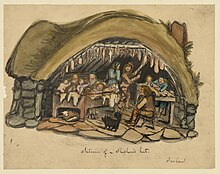

The Icelandic vistarband (Icelandic pronunciation: [ˈvɪstarˌpant]) was a requirement that all landless people be employed on a farm.[1] A person who did not own or lease property had to find a position as a laborer (vinnuhjú [ˈvɪnnʏˌçuː]) in the home of a farmer. The custom was for landless people to contract themselves to a farmer for one year at a time. The vistarband was in effect from 1490 until the beginning of the 20th century[2] in various forms. Iceland had an unusually large percentage of the population in this kind of bondage—generally about 25% of the population during the 19th century.
The institution only applied in Iceland, not in the rest of Denmark-Norway. Norway had its own system of serfdom, while a somewhat similar institution, the stavnsbånd, existed in Denmark proper.
- ^ Agnarsdóttir, Anna (2013-08-31). "Iceland in the Eighteenth Century: An Island Outpost of Europe?". 1700-tal. 10: 11–38. doi:10.7557/4.2619. ISSN 2001-9866.
- ^ Halfdanarson, Guomundur (1999). "Defining the Modern Citizen: Debates on Civil and Political Elements of Citizenship in Nineteenth-Century Iceland". Scandinavian Journal of History. 24 (1): 103–116. doi:10.1080/03468759950115872. ISSN 0346-8755.
